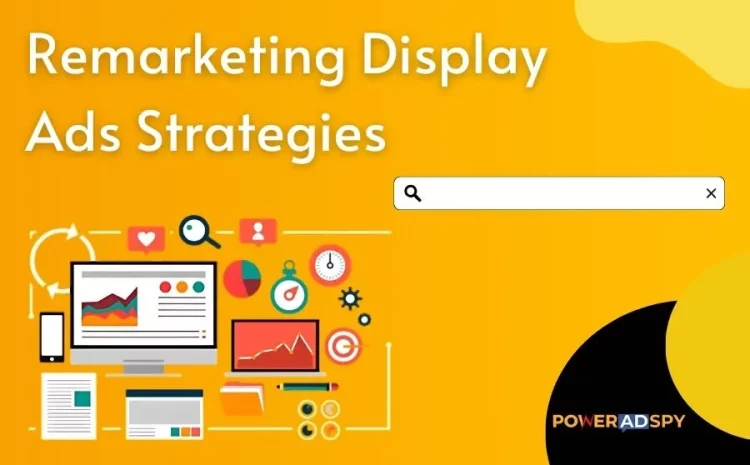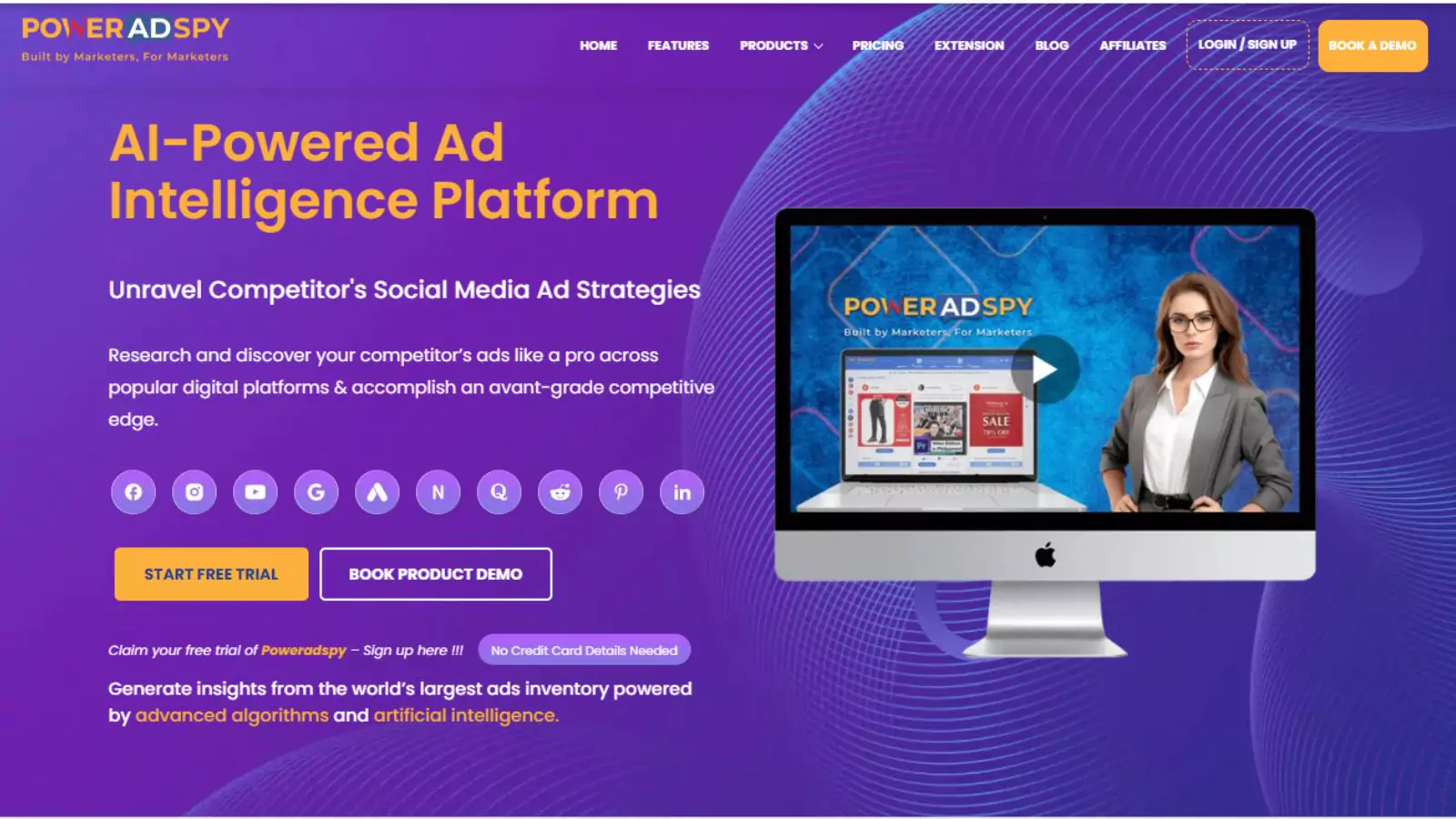Everything You Need To Know About Remarketing Display Ads
Have you ever browsed an online store, filled your cart, yet hesitated at the checkout? We have all been there. But what if, hours later, while scrolling through the Internet, you see that same item again—a subtle reminder from the store, nudging you to reconsider? That is the power of remarketing display ads.
This blog will delve into what remarketing display ads are and how remarketing can boost your conversion and sales.
Listen To The Podcast Now!
What are Remarketing Display Ads?
Remarketing display ads are a form of online advertising that targets users who have previously visited your website or used your app but did not complete a desired action, like finalizing a purchase or submitting a form.
These ads are strategically placed on various websites and social media platforms to remind potential customers of your products or services, encouraging them to return and complete their purchase.
What Makes Remarketing Display Ads Different?
While traditional display advertising involves placing banner ads across various websites, hoping to capture the attention of a broad audience, remarketing display ads take a more targeted approach. They specifically reach out to users who have previously interacted with your brand in some way. It could include:
- Visiting your website but not making a purchase
- Signing up for your newsletter
- Downloading a white paper
- Engaging with your social media content
By leveraging this past interaction, remarketing display ads offer several advantages:
Increased Relevance: The ads are tailored to users who have already shown interest in your brand or products. This relevance translates to higher click-through rates, which results in better conversions.
Enhanced Brand Recall: Seeing your brand again reinforces your presence in the user’s mind, keeping you top-of-mind when they are ready to decide on a purchase.
Refined Targeting: You can segment your audience based on their previous purchase behaviors to learn about what they like. Thereby, you can deliver highly personalized ad messages with high precision.
We have discussed why remarketing display ads stand out. Now, let us dive into why retargeting is effective.
What Makes Remarketing Effective
Remarketing is one of the most powerful advertising strategies available. When someone visits your website, whether they’re a potential or previous customer, they’re sending you a clear signal: they’re interested in what you’re offering and are considering making a purchase.
Retargeting allows you to reach out to these visitors again, reminding them of their initial interest. By showing them tailored Google display ads as they browse other websites or scroll through social media, you keep your product or service fresh in their minds. This gentle nudge can be the difference between a lost opportunity and a completed sale.
For example, let’s say John is looking for a new pair of running shoes. He visits your site, spends time reading reviews, and even selects a pair. But before he completes the purchase, he gets called into a meeting. Later, as he’s catching up on news or checking his Facebook feed, he sees an ad for those exact running shoes. This reminder reignites his interest, and he clicks the ad, returning to your site to finish the purchase.
How Does Retargeting Function?
Retargeting is a simple yet powerful strategy. Here’s a detailed breakdown of how it works from a website or company’s perspective:
Initial Visit:
- What Happens: When a visitor arrives at your website, they can do so either by directly entering your URL into their browser or by clicking on a link from another source
- Why It Matters: This initial interaction indicates an interest in your products or services, marking the beginning of the retargeting process.
Setting The Cookie:
- What Happens: When a visitor interacts with your website, a small piece of data is sent to their internet browser. This data, commonly known as a ‘cookie,’ allows websites to track user behavior. At SendGrid, we specifically call this tracking element the ‘SendGrid pixel.’
- Why It Matters: The cookie acts as a tracking device, allowing you to monitor the visitor’s activity on your site. This is crucial for understanding their interests and behaviors.
Tracking Activity:
- What Happens: The cookie keeps tabs on the pages and products that visitors view as they explore your website.
- Why It Matters: This tracking helps you gather valuable data on what the visitor is interested in, which is essential for creating personalized and effective retargeting ads.
Creating A Campaign:
- What Happens: By storing the cookie in the visitor’s browser, you can create a display ad campaign that identifies the visitor when they browse other websites. This way, your ads can follow them across the digital landscape, reinforcing your brand and encouraging engagement.
- Why It Matters: This step allows you to reach out to potential customers even after they leave your site, keeping your brand and products in their minds.
Showing Ads:
- What Happens: Once the visitor and the cookie are recognized on other websites, you can showcase display ads specifically tailored to their interests and browsing history.
- Why It Matters: Display ads based on their previous interactions with your site increase the chances of re-engaging the visitor and driving them back to complete their purchase.
Driving Return Visits:
- What Happens: As visitors explore other corners of the internet, your display ads pop up, gently nudging them with a friendly reminder about your website and the products they check out.
- Why It Matters: This reminder nudges the visitor to return to your site and complete their purchase, thereby converting their initial interest into a sale.
This was all about the remarketing world, now we will learn how to create retargeting Google ads.
Also Read
Shape Your Marketing Strategy With Google Display Ads
How To Unveil Competitor Display Ads On Instagram
Step-by-Step Guide: Google Retargeting Ads
Remarketing display ads are a powerful way to re-engage visitors who have already shown interest in your blog. You can encourage them to return to your site and boost your traffic by using personalized ads to target these users. Here is how to set up remarketing display ads for your blog using Google Ads:
Set Up Tracking
Choose Your Method:
- Decide between Google Tag Manager (more control) or the Google Ads tag (simpler).
Google Tag Manager:
2. Create a new account or sign in to your existing one at Google Tag Manager.
3. Set up a new tag and choose “Remarketing” from the tag type options.
4. Configure the tag with your Google Ads conversion ID (found in your Google Ads account).
5. Publish the container snippet and tag it to your website.
Google Ads Tag:
6. In your Google Ads account, navigate to “Tools & Settings” > “Audience Manager” > “Audience sources.”
7. Click “Website” and choose “Tag source.”
8. Copy the provided tag code.
9. Add the tag code directly between the <head> tags of your website’s HTML.
Build Your Remarketing Audience
10. In your Google Ads account, go to “Tools & Settings” > “Audience Manager” > “Audiences.”
11. Click “New audience” and choose “Website visitors.”
12. Select the website you want to track visitors for (if you have multiple).
Define Your Audience:
Here is where you choose who sees your remarketing display ads:
- All visitors: Target everyone who visits your website.
- Specific pages: Reach people who viewed specific blog posts (e.g., those related to a particular topic).
- Time spent: Target visitors who spent a certain amount of time on your website or blog (suggests higher interest).
- Engagement: Reconnect with people who downloaded something, commented, or interacted with specific elements.
You can also combine these criteria for more targeted audiences. Give your audience a descriptive name and save it.
Create Your Remarketing Display Ads Campaign
- Go to “Campaigns” in your Google Ads account and click “New campaign.”
- Choose “Display Network” as your campaign type (targets websites and apps).
Campaign Goals:
Select a goal that aligns with your purpose:
- Brand awareness & reach: Increase brand recognition among past visitors.
- Traffic: Drive more visitors back to your blog.
- Engagement: Encourage comments, shares, or newsletter sign-ups.
- Conversions: If you have downloadable content or sell products, optimize for purchases.
- Targeting: Under “Audiences,” choose the remarketing audience(s) you created.
Budget & Bidding:
Set your daily/total campaign budget and choose a bidding strategy:
- Maximize clicks: Get the most for your budget (good for traffic goals).
- Maximize conversions: Focus on getting people to take desired actions.
- Target CPA (cost-per-action): Specify the maximum amount you are ready to pay for conversions.
Ad Creation:
- Select “Responsive display ad” for flexible ad formats across different placements.
- Upload high-quality images relevant to your content and target audience.
- Write compelling headlines (short & long) and descriptions that highlight benefits.
- Incorporate a compelling call to action (CTA) like “Read More” or “Subscribe Now.”
- Create multiple ad variations with different visuals and text to test performance.
Monitor & Optimize:
Monitor your campaign’s performance and adjust strategies as necessary. Look at metrics like impressions, clicks, conversions, and cost-per-click (CPC).
Bonus Tip: Create different ad variations targeting specific blog categories or topics. It personalizes the ad experience for viewers.
We have set up the retargeting campaign, now it is time to learn some strategies.
Effective Strategies for Remarketing Display Ads
Remarketing display ads are a powerful tool for re-engaging past visitors and driving conversions. Here are some effective strategies to maximize the impact of your remarketing campaigns:
Segment Your Audience
Effective segmentation allows you to tailor your ads to specific groups of users based on their behaviors and interactions with your site. Consider these segments:
- All Visitors: Target everyone who visited your site.
- Product Viewers: Focus on users who viewed specific products or categories.
- Cart Abandoners: Engage users who added items to their cart but did not complete the purchase.
- Past Purchasers: Encourage repeat purchases by targeting previous customers.
- Time Spent on Site: Target users who spent a significant amount of time on your site, indicating higher interest.
Personalize Ad Content
Customized ads resonate more with users. Tailor your remarketing display ads content based on the specific actions users took on your site:
- Dynamic Ads: Use dynamic remarketing to show ads featuring the products or services users viewed on your site.
- Personalized Messaging: Craft messages that address the user’s previous interactions, such as reminders of abandoned carts or suggestions based on their browsing history.
- Special Offers: Include exclusive discounts or special offers to entice users to return and complete their purchase.
Optimize Ad Frequency
Achieving the optimal ad frequency is essential. Too few ads may not make an impact, while too many can annoy potential customers.
- Set Frequency Caps: Limit how often your remarketing display ads are shown to the same user to prevent ad fatigue.
- Test Frequency Rates: Experiment with different frequency caps to determine the optimal exposure for your audience.
Use Compelling Call-to-Actions (CTAs)
A strong CTA can significantly boost your ad’s effectiveness. Ensure your calls to action are clear, concise, and prompt the desired response.
- Examples: “Shop Now,” “Get 20% Off,” “Complete Your Purchase,” or “Learn More.”
- Urgency: promote a sense of urgency by using phrases like “Limited Time Offer” or “Sale Ends Soon.”
Leverage A/B Testing
Continuous improvement is key to successful remarketing campaigns. Use A/B testing to identify which remarketing display ads work best:
- Test Ad Variations: Experiment with distinct headlines, images, CTAs, and ad formats.
- Analyze Results: Measure performance metrics such as click-through rates (CTR), conversion rates, and return on ad spend (ROAS) to identify the most effective combinations.
Retarget Across Multiple Channels
Expand your reach by retargeting users across various platforms and devices:
- Google Display Network: Use Google’s extensive network to reach users on a broader range of websites and apps.
- Social Media: Utilize platforms like Facebook, Instagram, and LinkedIn for retargeting ads.
- Cross-Device Retargeting: Ensure your ads reach users across desktops, tablets, and mobile devices for a cohesive experience.
Focus on High-Quality Creatives
High-quality visuals and engaging remarketing display ads creatives are essential for capturing attention and driving conversions:
- Eye-Catching Designs: Use visually appealing images and graphics that align with your brand.
- Consistent Branding: Maintain consistent branding elements across all ad creatives to reinforce brand recognition.
- Engaging Content: Incorporate compelling and relevant content that resonates with your audience.
Set Clear Campaign Goals
Define specific, measurable goals for your remarketing campaigns to guide your strategy and measure success:
- Brand Awareness: Aim to increase brand recognition among past visitors.
- Traffic Generation: Drive more visitors back to your site.
- Engagement: Encourage users to interact with your site or content, such as commenting, sharing, or subscribing.
- Conversions: Focus on driving purchases, sign-ups, or other desired actions.
Remarketing display ads need precision and strategy, to maximize your campaign you must be aware of your competitors’ display ads. If you are seeking such a tool, we have got you covered.
PowerAdSpy – Google Ads Spy Tool
PowerAdSpy is a robust Google Ad spy tool designed to help digital marketers, advertisers, and businesses gain insights into their competitors’ advertising strategies on Google Ads. By offering advanced features and comprehensive analytics, PowerAdSpy enables users to:
Advanced Search And Filters – PowerAdSpy offers unparalleled ease in identifying the best ads and keywords driving paid and organic traffic to your competitors. It stands out by allowing searches and filters based on niches and Keywords. Additionally, you can filter by consumer interests, providing deeper insights into your potential leads.
Comprehensive In-depth Analysis – Gain valuable insights into your competitors’ Google Ad campaigns. PowerAdSpy lets you see which campaigns get the most clicks, the keywords they purchase, and the most effective keyword groups. With just one click, you can quickly access a wide range of valuable metrics, enabling you to refine your strategy effectively.
Faster Way To Spy On Competitor Ads – Eliminate the guesswork by browsing the complete ad campaign history of your competitors. Discover what works for them by examining the results of every ad split test they have conducted, allowing you to replicate their success in your campaigns.
See Everything With Keyword Search – Effortlessly find top-performing ads related to your targeted keywords by selecting specific keywords from ad copies. The keyword search feature enables comprehensive competitor-traffic-driven ad research in a single click, streamlining your competitive analysis process.
Conclusion
Effective remarketing display ads require a strategic approach combining audience understanding, compelling content, and clear campaign goals. By focusing on these elements, you can nurture past website visitors, rekindle their interest, and ultimately drive them back to your site to convert. Remember, successful remarketing is an ongoing process.
FAQs
What is remarketing in display advertising?
Remarketing in display advertising is a strategy where ads are shown to people who have previously visited your website. It uses cookies to track visitors and display targeted ads on other websites, reminding them of your products or services to encourage them to return and complete a purchase.
What is the CTR for retargeting display ads?
The click-through rate (CTR) for retargeting display ads is significantly higher than that of standard display ads. While standard display ads average around 0.07%, retargeting ads can reach 0.7% CTR on average, which is a tenfold increase.
What is the difference between display and remarketing?
Remarketing (or behavioral retargeting) targets a specific audience based on their interactions with your brand online. Retargeting aims to re-engage website visitors by showing them relevant ads on various websites, reminding them of your brand or product.
Display ads are visual banners or text ads that appear on websites, apps, or social media platforms. Display ads can be part of retargeting campaigns but are not limited to them. They serve broader purposes beyond re-engagement.










